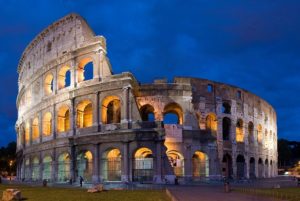$9.95
The Eturscans were here before the discovery of iron. Its discovery allowed them to construct instruments of agriculture, and they changed from nomadic societies, eventually building villages, towns, and great cities.
In Milan we see one of the monuments to their ideals...the Duomo, the great Cathedral which required 500 years to build. Milan also has what may be the oldest covered shopping mall anywhere. It was constructed in the 1880’s. Americans weren’t the first to think of enclosed shopping malls.
In northern Italy men carry purses, a popular custom here. Houses contain elegant courtyards and apartments where Italians may retreat from the street if they wish.
Near Milan is the Borolo Valley where the finest wines are produced. Italy is a major wine producing nation. Two hundred million gallons are exported to France each year, where it is mixed with small amounts of local wine and sold under French labels.
In Turin (called by the Italians Turino) an open air market reveals an astonishing variety of goods produced and sold in Italy. This also offers an opportunity to study some of those faces of Italy. Flowers are sold here and are produced by the ton! Italians do love their flowers.
Venturing into a remote area of western Italy there is the little mountain top village of Triora. This is a village that doesn’t appear on any tourist map. Walking the narrow streets of this medieval town seems like walking in a subterranean maze, even though it’s built on top of a mountain.
At the factory of Olio Sasso in Emperia, Italy, producers and bottlers of olive oil, we see them manufacture their own containers first. Typical of Italian industry they use their own ingenuity and hard labor as a natural resource, because Italy has no coal, no natural gas, and no petroleum.
Modern farming is the norm in Italy now. We don’t see quaint scenes of ox drawn plows. And farmers, along with everyone in the Country go on vacation in the month of August. And they all seem to go to the beach, on the Italian Riviera. Children play their games on the beach while the adults play theirs.
The working class, those who were once the peasant class, remain behind to do the physical work that feeds the populace. It is the time of tomato harvest. Italy produces 40 percent of all the world’s tomatoes.
On to Rome, and the universal symbol of the Roman Empire...the Colosseum. Built in AD 72 to AD 80 it could seat 50,000 spectators. It was so well built that it could be flooded with water so that ships could engage in battle in the Colosseum.

Rome is a nighttime city and window shoppers on the Via Veneto drink coffee, for $8 a cup, watching the faces of Italy go by. The traffic of Rome seems to deserve it’s reputation as the worst in the World, but Vespa riders defy danger as they scoot in and out of harrowing situations.
Further south a visit to Scicily shows Mt. Etna and its continuous lava fields that have overrun highways, but we can drive through the lava fields on paved roads today.
The most famous road in the world perhaps, the Via Appia....the Appian Way. It takes us to Benevento, the Arch of Trajan, through vast landscapes of vineyards, and on to Brindisi on the Adriatic Coast. Here fishermen bring in their catch at dawn to be auctioned off by the ‘patrone’ -- the boss.
Nearby are the strange conical houses of the Truli region, made of stones, including the roof, so neatly stacked that no interior support is necessary to hold them up.
Leonardo came from Vinci nearby. His achievements can stir wonderment at his massive intellect and ideas which seem so far ahead of their time.
In Venice there are the canals to wander through, then Verona where Romeo and Julliet actually lived, although 200 years before the time of Shakespeare. Another Colosseum in Verona is almost as magnificent as the one in Rome, and remind us that the empire of the Romans extended all the way to the Dolomite Mountains.
The Dolomites seem to reach for the sky in colossal monoliths, miles and miles in circumference. We’re not prepared for the rugged beauty and sheer size of these mountains. Mountain climbers give a sense of perspective and size.
Another of the ancient paved Roman roads can be seen, even in this northern region. It reminds us that the Roman Legions was a relatively small army, but because of the paved roads they could travel anywhere in the Empire in a fairly short time, and knowledge of this was enough to keep the peace within the Empire.
